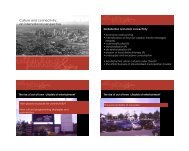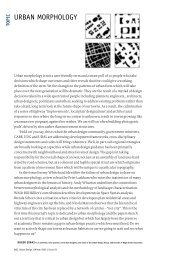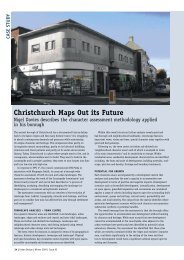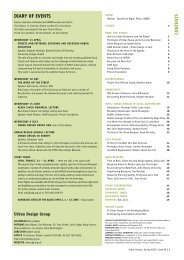topic - urban-design-group.org.uk
topic - urban-design-group.org.uk
topic - urban-design-group.org.uk
You also want an ePaper? Increase the reach of your titles
YUMPU automatically turns print PDFs into web optimized ePapers that Google loves.
TOPIC<br />
THE HOUSING MARKET RENEWAL AREA PATHFINDER<br />
PROGRAMME<br />
Martin Crookston reviews its origins, objectives and the role<br />
of <strong>urban</strong> <strong>design</strong><br />
East Lancashire; Merseyside<br />
• two in the West Midlands: Birmingham/<br />
Sandwell; North Staffordshire<br />
• one in the North East: Newcastle/<br />
Gateshead<br />
• two in Yorkshire & Humberside: South<br />
Yorkshire, and Hull/East Riding.<br />
Notable absentees are, perhaps, Teesside<br />
and West Yorkshire. Other declarations<br />
may be made, and other variants of the<br />
approach are being considered. Even<br />
so, this does represent a massive spread<br />
of interest, and allocation of resources,<br />
across a large swath of <strong>urban</strong> England.<br />
The Housing Market Renewal Area (HMRA) pathfinders have<br />
been described as ‘the biggest <strong>urban</strong> renewal project for a<br />
generation’. Certainly, they are on a par with the inner city<br />
renewal efforts of the 1970s Labour governments, and different in<br />
their scale and focus from the ‘targeted’ regeneration initiatives<br />
of the 80s and 90s. Their origins lie in a seminal series of reports<br />
prepared by the Centre for Urban and Regional Studies at<br />
Birmingham University (CURS), led by Brendan Nevin, which<br />
unpicked the ‘low demand’ areas of the North and Midlands<br />
– starting with Merseyside and working on through the M62<br />
corridor, Yorkshire, the North East and the Potteries. At the<br />
same time Max Steinberg, North West Regional Director for the<br />
Housing Corporation, was getting increasingly concerned about<br />
the long-term and strategic background to the investments<br />
the corporation was being asked to make in his region: and<br />
made those concerns clear to – amongst others – the Social<br />
Exclusion Unit and the Urban Task Force, in the late 90s. Nevin<br />
and Steinberg then (November 2001) put a key paper to the<br />
government, on behalf of the National Housing Federation,<br />
arguing that the next Comprehensive Spending Review must<br />
include a special programme to deal with this unforeseen and<br />
rapidly-emerging problem in the northern half of the country:<br />
the melting away of demand for housing, and particularly social<br />
housing, in many areas, and the social problems that this created<br />
or presaged.<br />
Government responded extraordinarily rapidly. In mid-2002,<br />
a £25 million start-up fund was allocated; in mid-2003 this<br />
was expanded to £500 million over the years to 2006; by early<br />
2004, the Manchester-Salford pathfinder had been awarded<br />
£150 million, Newcastle-Gateshead £69 million, and further<br />
announcements are now coming through.<br />
The programme, although not comprehensive (in the sense<br />
that it does not explicitly seek to tackle every area where low<br />
demand is an issue), is nonetheless much more broadly-targeted<br />
and ambitious than the area-based initiatives of the past two<br />
decades. There are nine pathfinders:<br />
• four in the North West: Manchester/Salford; Oldham/Rochdale;<br />
SCALE OF PROBLEM<br />
Just to give a flavour of what is being<br />
considered: the North Staffordshire (ie<br />
Stoke-on-Trent, Newcastle-under-Lyme,<br />
the Potteries) pathfinder put in a bid for<br />
its first three years for £30 million of<br />
HMR money, to be supplemented by £30<br />
million of other public-sector support<br />
(EP, Housing Corporation, housing<br />
associations); and with a 15-year estimate<br />
of £2.3 billion investment in the area, of<br />
which £860 million would be HMR, £568<br />
million other public sector, and £879<br />
million private investment. The initial<br />
award, from ODPM, is for the full £30<br />
million bid.<br />
These are big numbers. But so is<br />
the scale of the emerging problem.<br />
North Staffs has 67,000 dwellings in the<br />
pathfinder area (mainly, the old industrial<br />
core of the Potteries, plus some of the<br />
peripheral miners’ estates). Up to 14,500<br />
could be cleared; 12,500 new build is<br />
envisaged (so a net fall); and 36,000 would<br />
be refurbished. Even bigger is South<br />
Yorkshire – there, the pathfinder has<br />
150,000 dwellings in its Housing Market<br />
Renewal Area – essentially, the areas<br />
defined as ‘at risk’ of accelerating low<br />
demand in the CURS studies.<br />
THE CORE PURPOSES<br />
There is no doubt that this government<br />
is taking the issue really seriously. As<br />
Secretary of State, Stephen Byers said: “we<br />
are committed to turning round housing<br />
low demand and abandonment by 2016”.<br />
The ODPM has stated that “pathfinder<br />
strategic plans will entail radical and<br />
sustained action to replace obsolete housing<br />
with modern sustainable accommodation…<br />
[and to] …ensure… all the other<br />
essential requirements of sustainable<br />
communities”. The ODPM also makes<br />
18 | Urban Design | Autumn 2004 | Issue 92







